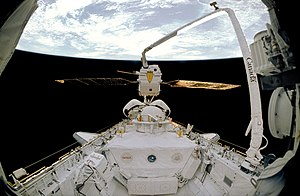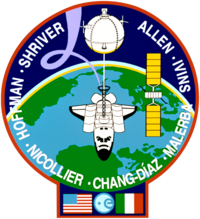


| |
| Names | Space Transportation System-46 |
|---|---|
| Mission type | EURECA satellite deployment Technology |
| Operator | NASA |
| COSPAR ID | 1992-049A |
| SATCAT no. | 22064 |
| Mission duration | 7 days, 23 hours, 15 minutes, 3 seconds[1] |
| Distance travelled | 5,344,643 km (3,321,007 mi) |
| Orbits completed | 127 |
| Spacecraft properties | |
| Spacecraft | Space Shuttle Atlantis |
| Launch mass | 116,134 kg (256,032 lb) |
| Landing mass | 94,676 kg (208,725 lb) |
| Payload mass | 12,164 kg (26,817 lb) |
| Crew | |
| Crew size | 7 |
| Members |
|
| Start of mission | |
| Launch date | July 31, 1992, 13:56:48 UTC |
| Rocket | Space Shuttle Atlantis |
| Launch site | Kennedy Space Center, LC-39B |
| Contractor | Rockwell International |
| End of mission | |
| Landing date | August 8, 1992, 13:11:50 UTC |
| Landing site | Kennedy Space Center, SLF Runway 33 |
| Orbital parameters | |
| Reference system | Geocentric orbit |
| Regime | Low Earth orbit |
| Perigee altitude | 425 km (264 mi) |
| Apogee altitude | 437 km (272 mi) |
| Inclination | 28.46° |
| Period | 93.20 minutes |
| Instruments | |
| |
 STS-46 mission patch  Standing: Ivins, Nicollier, Hoffman, Chang-Díaz, Malerba Seated: Allen, Shriver
← STS-50 (48)
STS-47 (50) →
| |
STS-46 was a NASA Space Shuttle mission using Atlantis and was launched on July 31, 1992, and landed on August 8, 1992.
| Position | Astronaut | |
|---|---|---|
| Commander | Third and last spaceflight | |
| Pilot | First spaceflight | |
| Mission Specialist 1 | First spaceflight | |
| Mission Specialist 2 | Second spaceflight | |
| Mission Specialist 3 | Third spaceflight | |
| Mission Specialist 4 | Third spaceflight | |
| Payload Specialist 1 | Only spaceflight | |
| Position | Astronaut | |
|---|---|---|
| Payload Specialist 1 | First spaceflight | |
| Seat[3] | Launch | Landing |  Seats 1–4 are on the Flight Deck. Seats 5–7 are on the Middeck. |
|---|---|---|---|
| S1 | Shriver | Shriver | |
| S2 | Allen | Allen | |
| S3 | Nicollier | Hoffman | |
| S4 | Ivins | Ivins | |
| S5 | Hoffman | Nicollier | |
| S6 | Chang-Díaz | Chang-Díaz | |
| S7 | Malerba | Malerba |
This section needs expansion. You can help by adding to it.
Find sources: "STS-46" – news · newspapers · books · scholar · JSTOR (January 2024) |
The mission's primary objectives were the deployment of the European Space Agency's European Retrievable Carrier (EURECA) and the joint NASA/ASI (Italian Space Agency) Tethered Satellite System (TSS-1). EURECA was deployed a day later than scheduled because of a problem with its data handling system. Seven and a half hours after deployment, the spacecraft's thrusters were fired to boost EURECA to its planned operating altitude of around 500 km (310 mi). However, thruster firing was cut to six minutes from twenty-four minutes because of unexpected attitude data from the spacecraft. The problem was resolved, and EURECA was successfully boosted to its operational orbit on the mission's sixth day. TSS-1 deployment also was delayed one day because of the problems with EURECA. During deployment, the satellite reached a maximum distance of only 260 m (850 ft) from the orbiter instead of the planned 20 km (12 mi) because of a jammed tether line. After numerous attempts over several days to free the tether, TSS-1 operations were curtailed, and the satellite was stowed for return to Earth. It would be reflown in 1996 on STS-75, with astronauts Allen, Hoffman, Nicollier and Chang-Díaz also flying again on that mission.
Secondary payloads included the Evaluation of Oxygen Integration with Materials/Thermal Management Processes (EOIM-III/TEMP 2A), Consortium for Materials Development in Space Complex Autonomous Payload (CONCAP II and CONCAP III), IMAX Cargo Bay Camera (ICBC), Limited Duration Space Environment Candidate Materials Exposure (LDCE), Pituitary Growth Hormone Cell Function (PHCF), and the Ultraviolet Plume Instrument (UVPI). The mission was extended by a day in order to complete scientific objectives.
![]() This article incorporates public domain material from websites or documents of the National Aeronautics and Space Administration.
This article incorporates public domain material from websites or documents of the National Aeronautics and Space Administration.
Gibson also was barred from T-38 jet trainer flights for one year while Walker was grounded for 60 days. Neither pilot will be eligible for reassignment to a shuttle mission until they are back on T-38 flight status.
|
Space Shuttle Atlantis (OV-104)
| ||
|---|---|---|
| Completed flights |
| |
| Status |
| |
| On display |
| |
|
| |||||||
|---|---|---|---|---|---|---|---|
| General |
| ||||||
| Facilities |
| ||||||
| Earth-based research |
| ||||||
| Spacecraft used |
| ||||||
| Mission highlights |
| ||||||
| |||||||
|
| |||||||||||
|---|---|---|---|---|---|---|---|---|---|---|---|
| Completed (crews) |
| ||||||||||
| Cancelled |
| ||||||||||
| Orbiters |
| ||||||||||
| |||||||||||
|
| |
|---|---|
| January |
|
| February |
|
| March |
|
| April |
|
| May |
|
| June |
|
| July |
|
| August |
|
| September |
|
| October |
|
| November |
|
| December |
|
Launches are separated by dots ( • ), payloads by commas ( , ), multiple names for the same satellite by slashes ( / ). | |